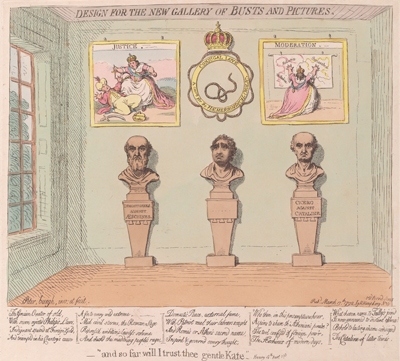Design for the New Gallery of Busts and Pictures
The first thing to say about this print is that its central image was most likely prompted by a speech of William Pitt's in the House of Commons on March 1st, 1792, defending his administration's role in the Armament against Russia. In the course of the speech, according to Cobbett's Parliamentary History of England,
He congratulated Mr. Fox on the triumphs he experienced in other places; and in answer to Mr. Sheridan's question as to what honours he (Mr. Pitt) imagined he should be received with if he went to Petersburgh, he said, he scarcely imagined he should have the honour of being placed in a gallery between two of the greatest orators of Greece and Rome. [Alluding to the bust of Mr. Fox placed by the empress of Russia between those of Demosthenes and Cicero.]**

© Trustees of the British Museum
Other details in the print (such as the painting on the wall titled "Moderation") can also be traced to the same speech. While reviewing the history of negotiations with Russia, for instance, Pitt reminds his audience that the Empress had proposed that
the provinces of Bessarabia, Moldavia, and Wallachia should be dismembered from Turkey and converted into an independent kingdom, and these terms the empress declared that she proffered as a testimony of her "great moderation."
And those are the same three areas that Catherine reaches for in the picture on the wall.
But Gillray was not the only caricaturist to take note of Pitt's speech and the "honor" extended to Fox. On March 15, two days before Gillray's print appeared, James Sayers produced The Patriot Exalted which shows Catherine the Great, with the assistance of the Russian Bear, hoisting the bust of Fox into place in its niche between Demosthenes and Cicero.

The Patriot Exalted [March 15, 1792]
© Trustees of the British Museum
It's likely that Gillray, who made a point of keeping abreast of his competitors, was well aware of Sayer's print. The frowns of Demosthenes and Cicero at finding themselves next to Fox, and the noose, prominently featured in Gillray's print over the head of Fox, may, in fact, derive from Sayers. But as usual when he borrows anything from another artist, Gillray always puts his own mark upon it. The noose in Gillray's print, under the title of "Conjugal Love" is aimed not at Fox but at Catherine who was rumored to have salved her own persistent itch by getting rid of her first husband and taking a succession of other lovers. And it continues the portrayal of Catherine as bloody, rapacious, and untrustworthy in the pictures on the wall and the quotation from Henry IV.
In Sayers print, the statues of Demosthenes and Cicero are identified by their names only. The point is that Fox has no right to appear in such august company. In the Design for the New Gallery of Busts and Pictures, Gillray adds the names of Aeschines and Catiline, the opponents of Demosthenes and Cicero and traitors to their respective countries. In the verses below the print, Fox is contrasted with the noble Greek and Roman, but also explicitly compared to Aeschines and Catiline. If, as the British Museum commentary suggests, the verses were composed by Pitt, they are consistent with the conclusion of his Parliamentary speech, where
He declared he was far from insinuating, that the gentlemen on the other side of the House had not in their opposition to the measures of [his] administration last year been activated by the purest intentions, but . . . so far from thinking as they did, that they had rendered an essential service to their country, he could not consider their triumph in any other light than as a triumph over the councils and interest of their country, and not its enemies.
——
** Amazingly enough, this was true. Catherine was extremely grateful to Fox for his opposition to Pitt's planned invasion of Russia, and on August 20, 1791, wrote a note to Count Vorontzov to ask him to thank Lord Fitzwilliam, Rockingham's nephew, for graciously agreeing to surrender
the bust of his friend, Mr. Fox, which I shall place in my collonnade in Tsarskoe Selo between Demosthenes and Cicero. This is a real gift to me at this particular moment.
The bust of Fox was the one by Nollekens of which multiple copes were made.
Sources and Reading
- Commentary from the British Museum on Design for the New Gallery of Busts and Pictures.
- Draper Hill, Mr. Gillray The Caricaturist, 1965, p. 69n
- "Charles James Fox," Wikipedia
- "Catherine the Great," Wikipedia
- "Russo-Turkish War (1787-1792)," Wikipedia
- "Triple Alliance (1788)," Wikipedia
- Cobbett's Parliamentary History of England
- Thomas Wright and R.H. Evans, Historical and Descriptive Account of the Caricatures of James Gillray #76
- Thomas Wright and Joseph Grego, The Works of James Gillray, the Caricaturist; With the History of His Life and Times, pp. 158-159.
Comments & Corrections
NOTE: Comments and/or corrections are always appreciated. To make that easier, I have included a form below that you can use. I promise never to share any of the info provided without your express permission.